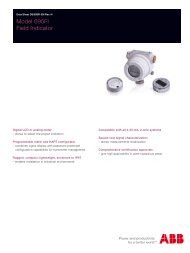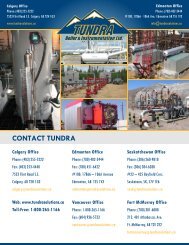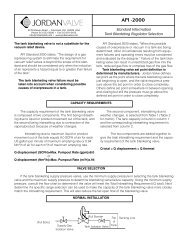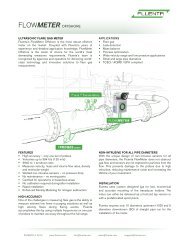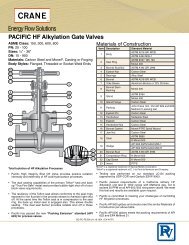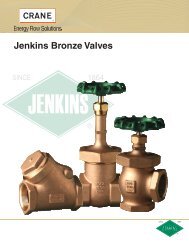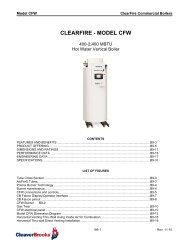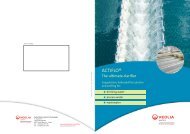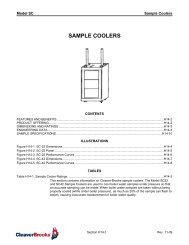Field Experiences with V–Cone® Technology - ABLE Instruments ...
Field Experiences with V–Cone® Technology - ABLE Instruments ...
Field Experiences with V–Cone® Technology - ABLE Instruments ...
You also want an ePaper? Increase the reach of your titles
YUMPU automatically turns print PDFs into web optimized ePapers that Google loves.
<strong>Field</strong> <strong>Experiences</strong> <strong>with</strong> V –Cone ® <strong>Technology</strong>McCrometer Inc.Hemet, CA.Abstract:The McCrometer V-Cone ® differentialpressure meter was introduced in the1980’s.Initial customer review of the technologyat that time was skeptical due to theradical change in emphasis of the flowregime from a central portion of a closedconduit (orifice plate) to fluid velocityprofile around a centrally mounted cone.This paper describes the principlesand field use of the McCrometer V-Cone D.P. flow meter used in the role ofwellhead metering, injectionmeasurement allocation metering,custody transfer of both topside andsub-sea in on-off-shore oil, and gasproduction applications.Introduction:The McCrometer V-Cone meter is adifferential pressure device which allowsthe fluid to be measured to pass aroundthe exterior of a central dual cone thelarger cone apex being upstream of abeta edge, and an acute angled smallertransition cone being on thedownstream side of this edge.center <strong>with</strong> a low amplitude. Thisparameter is particularly beneficial ifparticulate laden fluids are to bemeasured which will be mentioned laterin the paper.A significant flow conditioning or flowprofiling affect is obtained by thegeometry of the larger cone whichcauses an averaging of the fluidvelocities directly up-stream of the conebeta edge.Independent testing has shown thisaffect to occur <strong>with</strong> close coupled out ofplane elbows, and single elbows atelevated Reynolds numbers..Consideration must be given to anyinstallation that employs an upstreamdisturbance producer other than anelbow, such as a gate valve or devicewhich can produce jetting or highvelocity fluid distortion past the cone.Practical experience has shown that inthese extreme cases a 3-5 diameterupstream section will suffice to allow thesufficient fluid expansion needed toallow the cone to regenerate the velocityprofile. (Fig 1)Pressure DistributionFlow velocities in the up-stream core ofthe pipe are then forced to mingle <strong>with</strong>pipe wall boundary layer velocities byradial expansion across the larger cone.After passing this beta edge (formedbetween the two cones and the pipewall) the fluid then enters into a centralregion in which high frequency vorticesform adjacent to the pipe wall and pipeHighFig 1Low3255 W. Stetson Ave., Hemet, CA 92545-7799 USA – Tel (951) 652-6811/Fax (951) 652-3078www.mccrometer.com © 2005-2008 by McCrometer, Inc./ Printed in USA Lit#24508-90 Rev 1.3/04-08Page 1 of 12
system. Long-term vulnerability usingorifice plates in production separatorscan be demonstrated by examiningpublic documents in the measurementfield *.(*Examples cited in this document fromPhillips Petroleum Embla–Platform NSFMWGas Measurement for the Real World, 1994)assumed at the start up case. Greaterliquid injection over time to obtain moreproducts on declining wells can result inan increase in wetness at the gas outlet.Examples of this can range from underreadingof the meter or over-readingdepending on Reynolds Number Betaratio, and liquid mass fraction seen atthe meter.Orifice <strong>Technology</strong> Issues:Beta Edge Degradation, StagnationArea, and Deposition.During the use of a velocity profilesensitive device (as an orifice) it isnecessary to confirm that the beta edgeof the device is both clean and has notbeen compromised due to debris andother contaminants.Current API paper standards address aclean dry and non-polluted gas, whichdoes not take into account generally anoffshore usage condition, i.e. ”wet gas.”This can result in high maintenance andintervention cost due to frequent platechanges.Where paraffin or sulphate depositionoccurs in the pipe, in almost all casesthe shift in the Cd is caused due to a recirculatoryeffect at the rear of the orificeplate. There also can be a stagnationarea up-stream of the device whereheavy end hydrocarbons can collect.(See enclosed Photo examples from MarathonOil site Appendix A and longevity issues later inthe paper)Wet Gas:Current AGA/API standards do notaddress wet gas installation conditions;hence the use of an AGA/API standardto design a possible wet gas meteringsystem can also end in higherintervention costs not generallyResearch in this field by Chevron andothers indicates a Cd movement of over2%-3% outside of the predicted APIrequirements due to wet gas <strong>with</strong> liquidloads of only 0.33bbl/MMscf asindicated in research.Reference:Dr V.C. Ting Chevron Corp. “Effect ofLiquid Entrainment on Orifice Meters.”Wet Gas Lab Test CEESI, Nunn, CO.:Recent Wafer-Cone ® testing at CEESIindicated a low susceptibility to Cdchange <strong>with</strong> liquid load. Base linevalues were plotted against numeroustest loop instruments in a dry condition.Flow rates from 7 –70 feet / second in a4 inch line size where used. The liquidrate was added to a maximum of 1 and2 Bbl per MMSCF. The liquidhydrocarbon was a Decane derivativeacceptable for use in closedsurroundings.The results were plotted and the effectsnoted. Further work is underway to seethe effect of low D.P. ranges onrepeatability, accuracy, and Y factorchanges (currently the welded versionhas a Y factor equation available tocorrect for density changes due topressure).(See Appendix C Fig 8) - (CEESI = ColoradoExperimental Engineering Station Courtesy ofChevron, Inc. USA).3255 W. Stetson Ave., Hemet, CA 92545-7799 USA – Tel (951) 652-6811/Fax (951) 652-3078www.mccrometer.com © 2005-2008 by McCrometer, Inc./ Printed in USA Lit#24508-90 Rev 1.3/04-08Page 3 of 12
BP Amoco <strong>Field</strong> TestDuring March, 2001 BP tested aMcCrometer V-Cone in an upstreamfield condition.A 4 inch ∅ Wafer-Cone cone was tested<strong>with</strong> a 4 inch ∅ orifice plate 36 inchesup-stream and a separator downstream.The results were very impressive. (SeeAppendix C Fig 7)Longevity, Contamination, and BetaEdge Damage Lab TestDuring late 1998 and early 1999Marathon Oil installed test meters attheir on-shore hydrocarbon facility incentral Wyoming. The site wasproducing dirty wet gas <strong>with</strong> H2s andasphaltene contaminants. The result onthe existing measurement system wasnot very pleasing to the client or to thelocal BLM office that collect royalty fromthese gas systems. The use of theMcCrometer V-Cone was to see if thecontamination would affect the meter.The assumption that it would work wasa driving force to implement theinstallation. Three-inch (3”) meterswhere fitted and the most severe wellused as a test site. (See appendix A & “A-1:Orifice trash deposits”)On inspection, the orifice plate unitsshowed debris build up after only threemonths usage <strong>with</strong> Asphaltene/Paraffindeposition at the up-stream inlet to themeter and contaminants after the platein the low pressure region.On inspection of the McCrometer V-Cone the unit (Appendix A) did not showthe same severity, probably due toaccelerated flow around the coneelement. This seemed to keep the coneand sensing ports clear of deposition,thus maintaining a consistent D.P.across the meter. Entrained condensateliquid moved into slug flow conditionperiodically, which caused liquid to enterthe orifice sensing lines and also beretained after the plate. The cone meterdid not show this problem due to thestraight through design. The regular“blowing” off of the plate was deemed asevere problem in man hours andtraveling to the site, plus the effect onaccuracy this caused. With the lack ofliquid retention using the McCrometer V-Cone the system now runs <strong>with</strong>in theBLM “IM” guidelines.Damage TestDamage testing of the Wafer-Conemeter was recently performed, thisinvolved determining a base line on acalibration rig over several flow rates,after which intentional damage to thecone beta edge was performed in asevere manner. The photographs and data *are shown in Fig 5 and Fig 6*Fig 5Fig 63255 W. Stetson Ave., Hemet, CA 92545-7799 USA – Tel (951) 652-6811/Fax (951) 652-3078www.mccrometer.com © 2005-2008 by McCrometer, Inc./ Printed in USA Lit#24508-90 Rev 1.3/04-08Page 4 of 12
Test Results (damage testing)The deviation from the test shows theCd shifted by app. +0.3% which is <strong>with</strong>inthe uncertainty of the McCrometercalibration station.This initial test is currently beingsuperseded by further tests <strong>with</strong> multipledamage regimes to view the effect perincident.This work is a pre-courser to the use ofthe meter in a sub sea “nonintervention”environment.(See appendix D Fig 9)Weight Penalty (platform design):Current design of orifice systemsrequires large up and downstream pipelengths. This is not desirable if you area user since cost of real estate is at apremium offshore due to the largeweight related cost in installing, largepipe runs, orifice carriers, andsupporting structures.Current weight penalty costs in the Gulfof Mexico can be greater than $25 perpound.Installing a system including all pipingrequirements and a cast carrier canamount to high dollar amounts in theplatform support requirements. This canbe compounded on deep waterplatforms.Therefore using a device, which has lowweight and reduced up-downstreampiping needs, can reduce overall clientinstallation costsInstallation cost relating to weightpenalty:The McCrometer V-Cone can performits own velocity profile conditioning aspart of the meter design. The installationenvelope can be reduced significantlyand direct coupling to elbows can bestraight to the meter flange face <strong>with</strong>outCd performance degradation due toswirl or profile skewing.Please note that the McCrometer V-Cone weight is approximately only 1444lbs for a 16inch #900 meter, 1161 lbs for14 inch meter and only 945lbs for a 12inch. This is significantly lighter thanboth orifice carriers and respective updownstreampiping for these sizesystems, which can weigh more than2.5 tons, per stream.McCrometer V-Cone <strong>Technology</strong>Technical Attributes:Accuracy using laboratory calibration ispossible to facilitate an accurateperformance over 10-1 turndown betterthan that of conventional differentialproducers. Performance of +/- 0.5% at10-1 turndown, <strong>with</strong> debris resistance,low beta edge degradation (Beta edge isafter the flow on McCrometer V-Cone),and no stagnation area make the unitideal for high cost intervention areasand long-term performance. The lowweight of the device will ensureeconomy of installation <strong>with</strong>out having topurchase long piping lengths and highdollar flow conditioners/profilers (certain12 inch diameter flow profile generatorunits can cost over $10,000).Sub Sea Implementation and DesignCurrently 35 precision tube units are inservice in a sub-sea wellhead marineenvironment, in the U.K., Norway,Angola, Brazil and the South China Seaarea. The main usage has been waterinjection metering; however, allocationgas metering has been a recentlyaccepted philosophy <strong>with</strong> the device.Implementation to greater than 12000feet is acceptable <strong>with</strong> a newconfiguration and special sensorhousing. (See Appendix D Fig 10)3255 W. Stetson Ave., Hemet, CA 92545-7799 USA – Tel (951) 652-6811/Fax (951) 652-3078www.mccrometer.com © 2005-2008 by McCrometer, Inc./ Printed in USA Lit#24508-90 Rev 1.3/04-08Page 5 of 12
Appendix AWet Gas Photographs Wellhead MeteringWafer Body ofMcCrometer Wafer-Cone3 inch Diameter (9 monthinspection)3255 W. Stetson Ave., Hemet, CA 92545-7799 USA – Tel (951) 652-6811/Fax (951) 652-3078www.mccrometer.com © 2005-2008 by McCrometer, Inc./ Printed in USA Lit#24508-90 Rev 1.3/04-08Page 6 of 12
Appendix A-1Wet Gas Photographs WellheadThree months inspection for wet gas line (H2s + paraffin’s)3255 W. Stetson Ave., Hemet, CA 92545-7799 USA – Tel (951) 652-6811/Fax (951) 652-3078www.mccrometer.com © 2005-2008 by McCrometer, Inc./ Printed in USA Lit#24508-90 Rev 1.3/04-08Page 7 of 12
Appendix BGas Production Separator(Typical Arrangement)(BP Norwood Separator Site Wy. USA)Gas OUTOrificeV-Cone30 diameters Proved Orifice MeterWith Mobile Gas Prover4 inch lineNGL / Retrograde30 diameters36 inches12 inchesH2OWellheadGas + Water + HydrocarbonsV-Cone vs. Orifice Plate & Separator540520500MCFH48046044042017:00:0018:00:0019:00:0020:00:0021:00:0022:00:0023:00:000:00:001:00:002:00:003:00:004:00:005:00:00Time6:00:007:00:008:00:009:00:0010:00:0011:00:0012:00:0013:00:0014:00:0015:00:0016:00:00MCF-VconeMCF-NorwoodMCF-Orifice3255 W. Stetson Ave., Hemet, CA 92545-7799 USA – Tel (951) 652-6811/Fax (951) 652-3078www.mccrometer.com © 2005-2008 by McCrometer, Inc./ Printed in USA Lit#24508-90 Rev 1.3/04-08Page 8 of 12
Fig 7Appendix CData from BP/ Norwood Separator Site Wy--TIME--MCF-V-ConeMCF-NorwoodMCF-OrificeDP-Norwood DP-Orifice -PSIA- -DEGF- --MMBTU--17:00:00 504.053 504.41 489.526 153 51.5 373.5 119.9 479.70818:00:00 509.756 496.5 495.586 148 52.5 375.6 119.9 485.13519:00:00 519.024 526.25 505.496 165 54.7 374.9 119.6 493.95520:00:00 496.692 504.04 484.337 152 50.6 371.7 119.5 472.70221:00:00 495.705 484.87 482.686 141 50.3 371.9 119.4 471.76222:00:00 500.691 493.45 488.556 145 51.3 373.2 119.4 476.50723:00:00 502.829 506.04 491.551 152 51.9 373.8 119.4 478.5430:00:00 497.401 503.08 485.979 152 51.2 369.8 119.3 473.3761:00:00 491.94 496.79 480.75 150 50.2 369.4 119.3 468.182:00:00 487.84 490.04 476.625 145 49.1 371.2 119.3 464.2773:00:00 495.004 491.04 484.341 144 50.6 371.5 119.2 471.0964:00:00 500.487 504.5 490.445 152 51.8 372.3 119.2 476.3145:00:00 488.422 486.87 477.947 142 49.4 370.7 119 464.8316:00:00 484.779 484.45 474.372 142 48.9 369 119 461.3647:00:00 483.022 479.67 472.455 138 48.6 368.4 119 459.6928:00:00 479.931 483 469.689 142 48.3 366.5 118.9 456.759:00:00 477.279 479.58 467.129 140 47.6 367.8 118.9 454.22610:00:00 476.231 476.83 466.232 138 46.9 370.9 118.8 453.22811:00:00 486.98 478.54 477.817 139 50.7 361.3 118.6 463.4612:00:00 481.302 481.29 472.392 145 49.4 362.8 118.6 458.05513:00:00 470.997 463.2 462.513 128 45.4 376.7 118.7 448.24814:00:00 470.623 471.2 461.351 131 0 373.2 118.7 447.89115:00:00 470.861 474 461.711 134 45.7 373 118.7 448.11916:00:00 499.061 477.33 489.357 136 54.2 355.3 118.6 474.957Totals 11770.91 11736.97 11508.8433255 W. Stetson Ave., Hemet, CA 92545-7799 USA – Tel (951) 652-6811/Fax (951) 652-3078www.mccrometer.com © 2005-2008 by McCrometer, Inc./ Printed in USA Lit#24508-90 Rev 1.3/04-08Page 9 of 12
Fig 8Wafer-Cone CEESI Calibration Test--Wet Conditons,0.5 Beta at 80 psig (Raw data)Discharge Coefficient,Cd0.980.960.940.920.90.880.860 200000 400000 600000 800000 1000000 1200000Cd-DryCd-1bbl/MMSCFCd-2bbl/MMSCFPipe Reynolds Number D=3.826"3255 W. Stetson Ave., Hemet, CA 92545-7799 USA – Tel (951) 652-6811/Fax (951) 652-3078www.mccrometer.com © 2005-2008 by McCrometer, Inc./ Printed in USA Lit#24508-90 Rev 1.3/04-08Page 10 of 12
Appendix DFig 9WAFER-CONE VH03DAMAGED CONE CALIBRATION DATAFlowmeter Cf0.9000.8950.8900.8850.8800.8750.8700.8650.8600.8550.850baseline no damageheavily damaged cone0.8450 20000 40000 60000 80000 100000 120000 140000 160000ReFig 10Deviation < 0.3%3255 W. Stetson Ave., Hemet, CA 92545-7799 USA – Tel (951) 652-6811/Fax (951) 652-3078www.mccrometer.com © 2005-2008 by McCrometer, Inc./ Printed in USA Lit#24508-90 Rev 1.3/04-08Page 11 of 12
Reference Documents / Data:HaywardA Basic Guide and SourceBook for Users 1973Szabo / Winarski V-Cone Meter for NaturalHypnar Gas Flows 1992Miller Flow Measurement (Latest Edition)HandbookGRI Wet Gas Research 1997V-Cone 4 inch DiameterBright BP Amoco Wy test separator 2001data3255 W. Stetson Ave., Hemet, CA 92545-7799 USA – Tel (951) 652-6811/Fax (951) 652-3078www.mccrometer.com © 2005-2008 by McCrometer, Inc./ Printed in USA Lit#24508-90 Rev 1.3/04-08Page 12 of 12





